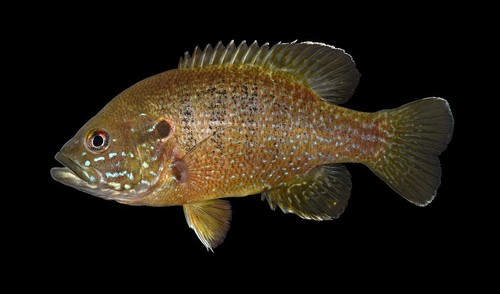
Green Sunfish
Bluefin tuna, belonging to the genus Thunnus, are among the most remarkable fish in the ocean. Known for their size, speed, and commercial value, they play a crucial role in marine ecosystems. This article explores their life, from habitat to conservation status.
4 10 years
Lifespan
7.6 - 25 cm
Length
Least Concern
Conservation Status
20 km/h
Swimming speed
Insectivorous, Carnivorous
Diet
Local Migration
Migration
Appearance Overview
The Bluefin Tuna is renowned for its sleek, torpedo-shaped body, perfectly adapted for speed and endurance in the water.
Color
Dark metallic blue on top blending into a silvery underside.
Fins
Two dorsal fins, with the second being taller than the first.
Body
Streamlined body with a crescent-shaped tail.
Length
Up to 10 feet (3 meters)
Weight
Up to 1,500 lbs (680 kg)
Diet
Carnivorous, feeding on a variety of fish, squid, crustaceans, and occasionally, zooplankton.
Feeding Behavior
Hunts by sight and uses incredible speed to chase down prey, sometimes cooperatively to herd schooling fish.
Social Behavior
Forms schools, especially when young. Larger individuals may be solitary or form smaller groups. Highly migratory.
Commercial Relevance
Extremely high value, particularly in sushi and sashimi markets, driving significant commercial fishing pressure.
Conservation measures
Fishing quotas, minimum size limits, seasonal closures, and international agreements to manage stocks and reduce bycatch.
Status
Varies by species; Atlantic Bluefin Tuna is Endangered, Pacific Bluefin Tuna is Vulnerable, Southern Bluefin Tuna is Critically Endangered.
Threats
Overfishing is the primary threat, exacerbated by high commercial value. Climate change and habitat degradation also pose risks.
Habitat Distribution
Depth Range
0-900 meters (0-2,950 feet), though they can dive much deeper.
Geographic Range
Atlantic Ocean, Pacific Ocean, and Southern Ocean, including the Mediterranean Sea.
Preferred Environment
Temperate and subtropical waters; open ocean (pelagic) and coastal areas.
Reproduction and Life Cycle
Breeding Habits
Spawns in warm waters; Atlantic Bluefin Tuna have two main spawning grounds: the Mediterranean Sea and the Gulf of Mexico.
Development Stages
Eggs hatch into larvae, which develop rapidly in plankton-rich waters. Juveniles grow quickly, eventually reaching their large adult size.
Fecundity
Females can produce millions of eggs per spawning season, depending on their size and condition.
Maturity Age
Varies by species; Atlantic Bluefin Tuna typically mature between 4-8 years.
Faqs about Green Sunfish
How fast can Bluefin Tuna swim?
Bluefin tuna are among the fastest swimmers in the ocean, capable of bursts of speed up to 43 mph (70 km/h).
How long do Bluefin Tuna live?
They can live up to 40 years, though this is becoming increasingly rare due to fishing pressure.
Do Bluefin Tuna migrate?
Bluefin tuna undertake long migrations, often crossing entire oceans, for feeding and spawning.
Are Bluefin Tuna warm-blooded?
Yes, they are warm-blooded, which is unusual for fish. This allows them to maintain high body temperatures in cold waters.
Why is Bluefin Tuna so expensive?
The high fat content and rich flavor make it a prized ingredient in sushi and sashimi.
Where do bluefin tuna fit in the marine food chain?
They are apex predators at the top of the marine food web
Copyright @ Nature Style Limited. All Rights Reserved.
 English
English